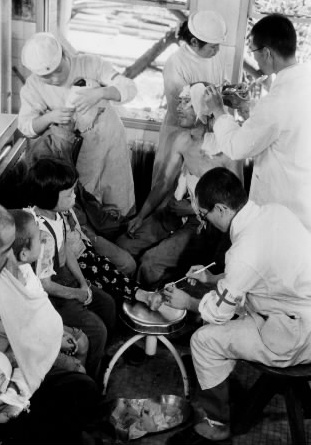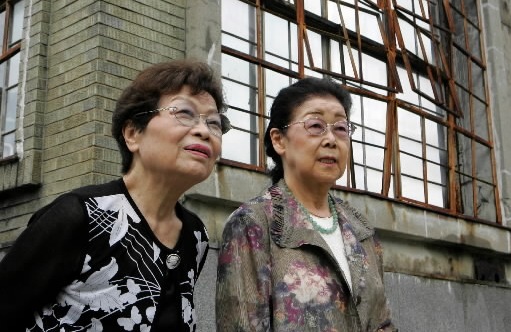Images of the Atomic Bombing, 1945~2007, Part 3
Jun. 27, 2010
Hospital in the burnt ruins
by Masami Nishimoto, Senior Staff Writer
What were the consequences of the atomic bombing of Hiroshima? What consequences continue to linger on? This series [originally published in August 2007] traces the people linked to photographs which record the A-bomb devastation. With some voices in Japan now contending that the nation should arm itself with nuclear weapons, it is time to stress the reality of the destruction these weapons wreak.
Numbed by the bombing
This photo was taken in the main building of the Hiroshima Red Cross Hospital by Shunkichi Kikuchi, a photographer from Tokyo who died in 1990 at the age 74. It is a scene from the outpatient ward, taken on October 4, 1945, according to the book "Atomic Bombing: Testimony by an A-Bombed Doctor," by Tatsutaro Hattori. Mr. Hattori, who died in 1993 at the age of 89, was head of the hospital's surgery department. The hospital treated a huge number of the wounded in the aftermath of the bombing. The woman with the bandage in the upper left of the photo was 17 years old at the time, a second-year nursing student. These students, although injured themselves, remained in the devastated hospital buildings amid the ruins and cared for the wounded.
Kimie Oshima (maiden name, Mori), 79, of Saeki Ward, Hiroshima City, can be seen bandaging the patient. As she gazed at the picture, she began her account by saying, "I don't even recall what I was eating at the time. I was so busy taking care of the patients."
Naoe Takeshima, 79, of Naka Ward, added to Ms. Oshima's story. "By October, the hospital windows still had no window panes so we had to hang straw matting over them." Both women were at the Hiroshima Red Cross Hospital when the bomb exploded, and immediately took up their relief efforts.
They were in their second year of the Hiroshima Red Cross Society's First Rescue Nurse Training Program. When the bomb exploded, Ms. Oshima was blown out into the alley next to the North Hospital Building. Ms. Takeshima was pinned under the collapsed remains of the wooden two-story main dormitory building, but was rescued from the rubble.
Prompting each other's memories, the two women shared their stories in detail.
"The head nurse told those of us who could walk to proceed with relief work, so I headed for the front entrance," said Ms. Takeshima. Added Ms. Oshima, "The front entrance was jammed with people, all the way to the streetcar tracks. Some were completely covered in blood, strips of skin dangling from their bodies."
The three-story ferroconcrete Main, Central and North Buildings escaped fire because soldiers managed to keep it from spreading, but the wooden South Building and dormitory were consumed by flames. The fire also damaged the Hiroshima Branch of the Postal Savings Bureau to the south.
The students swatted out the falling sparks and hastily gathered medicines from the buildings. They applied white zinc ointment to burned skin and covered affected areas with antiseptic-soaked gauze. With the moans of the injured rising all around them, they spent the night in the ruins.
Starting the next day, the women administered first aid in conjunction with rescue teams that had rushed in from the Red Cross Hospitals in neighboring Yamaguchi and Okayama Prefectures. They also cremated bodies. At night, the smoldering remains glimmered here and there. Ms. Oshima recalled that when she went out to fetch water, bones rustled under her footsteps.
Ms. Takeshima was told to go home because her back was badly injured. On August 11, she returned to her house in today's Fuchu City, Hiroshima Prefecture. Her gums bled, and her hair began to fall out as she combed it.
Even after the war ended, the hospital sitting in the ruins continued to nurse the sick and injured. Deaths as a result of acute radiation poisoning mounted. "When a patient's nosebleed wouldn't stop," explained Ms. Oshima, "the person was dead the next day. Still, I never felt sorrow or horror. My human feelings had become completely numbed by the bombing."
Of the 105 students who entered the nursing program in 1945, only 65 were able to graduate the next spring. Four perished outright in the bombing. Many others were forced to give up their studies due to A-bomb-related afflictions.
The two women went on to become teachers of nursing and continued in this role until their retirement. Ms. Takeshima occasionally spoke about her A-bomb experience, believing that "telling others about one's experience is a survivor's duty." Encouraged by Ms. Takeshima's example, Ms. Oshima shared her own story in public for the first time in 2005. It was on the occasion of the unveiling of the Marcel Junod Memorial. This memorial, an effort of the Hiroshima Prefectural Medical Association and the Japan Red Cross Society Hiroshima Chapter, was raised to recognize Dr. Junod, who visited the devastated city in the aftermath of the bombing with 15 tons of medical supplies.
One photo that was taken in the ruined hospital reminded the women of a sad event. The photo shows one of their classmates lying on a bed, her left eye blinded by shards of glass. "I really feel sorry for her…" the two murmured. Twelve years after the photo was taken, they learned that their friend had committed suicide.
Even these precious images cannot capture every tragedy wrought by the atomic bombing.
(Originally published on August 11, 2007)









